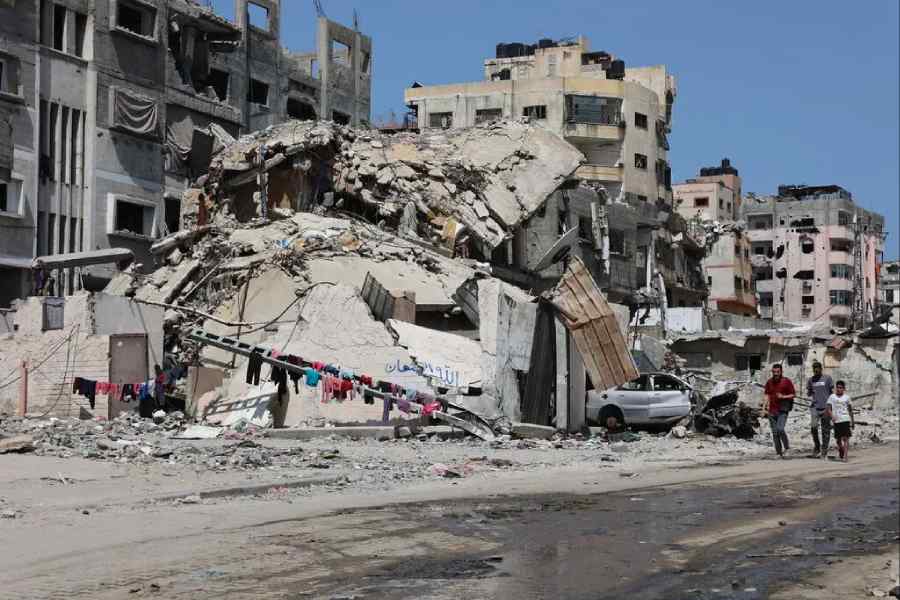Ain al Hilweh, Lebanon’s largest community of Palestinian refugees and their descendants, has long been a downtrodden place, impoverished and racked by factional violence. Its residents usually have a grim view of their future.
But now, the mood here is nothing but exuberant.
Recruitment for Hamas and its armed wing, the Qassam Brigades, is way up across Lebanon’s 12 Palestinian refugee communities, according to Hamas and Lebanese officials. They say that hundreds of new recruits have joined the militants’ ranks in recent months, exhilarated by Hamas’ ongoing war with Israel.
On a rare visit to Ain al Hilweh, journalists from The New York Times saw posters of the Qassam Brigades’ spokesperson, Abu Ubaida, everywhere, his eyes peering out from a red and white checked scarf wrapped around his face like a balaklava, imploring residents to “fight on the path of God.”
In Hamas’ stronghold, the Gaza Strip, where some 40,000 Palestinians have died in ten-and-a-half months of war, many people have soured on the group. But elsewhere, Hamas’ willingness to combat Israel has won new adherents.
“It’s true that our weapons cannot match our enemy’s,” Ayman Shanaa, the Hamas chief for this area of Lebanon, said in an interview. “But our people are resilient and they support the resistance. And are joining us.”
Young men milling in a street in Ain al Hilweh said this was the first time they were hopeful, and they each knew dozens of family members or friends who had joined Hamas since the war began in October. Such enlistment doesn’t affect the fight in Gaza because getting into the territory is prohibitively hard, but it bolsters Hamas in Lebanon. Recruits typically remain in the community, helping to manage local affairs, and sometimes approach Lebanon’s southern border to launch rockets into Israel.
The young men were upbeat that Hamas could win for Palestinians the ability to return to the only home they acknowledge, the land that is now Israel. That such a return will occur has long been an article of faith for Palestinian refugees.
In the late 1940s, in the wars surrounding the creation of Israel, Jewish forces expelled many Palestinian Arabs, and many others fled in anticipation of violence. Israel has not allowed them or their descendants to return or reclaim ownership of property.
Hundreds of thousands of Palestinians settled in refugee camps in the West Bank, Gaza, Lebanon, Jordan and Syria. Over decades the camps became built-up towns — often still called camps — that are home now to millions.
In Lebanon, those Palestinians have been barred from gaining citizenship or holding a wide range of jobs.
One such community is Ein al-Hilweh, with 80,000 residents crammed into barely half a square kilometre, largely within Sidon, a southern port city. There is no shortage of men here willing to sacrifice their lives to fight Israel, Shanaa said, but he refused to say how many had been recruited from the Sidon area.
He spoke at a Hamas-run community centre where men sat drinking coffee and eating dates while they watched gory footage from the Israel-Hamas war. Pictures of the recently assassinated Hamas political leader, Ismail Haniyeh, colored in by children, adorned the walls.
On the streets, a new recruitment poster for the Qassam Brigades showed dozens of smiling young men and boys barely out of middle school superimposed onto Al-Aqsa Mosque in Jerusalem, a site revered by Muslims. Hamas named its October 7 attack on Israel — which left about 1,200 people dead, kidnapped around 250 and sparked the ongoing war in Gaza — “Al-Aqsa Flood”.
The poster offered a training workshop for the new “Al-Aqsa generation”, declaring that Jerusalem is “for us”.
Some Palestinians claim Abu Ubaida as their Che Guevara, the long-dead Marxist revolutionary who remains a cultural touchstone. Inside Ein al-Hilweh, Abu Ubaida’s picture is nearly omnipresent, adorning scarves and key chains.
For years the Lebanese military has barred journalists from entering Ein al-Hilweh, where armed factions have repeatedly battled each other, and the Lebanese military, for control. Under a decades-old international agreement, the military generally stays out of Palestinian enclaves, which operate quasi-independently within a nation where the weak central government can barely provide electricity, let alone security. But journalists from the Times were able to enter the town, swept up in a crowd of mourners during a funeral procession for a Hamas official.
New York Times News Service










